8 strategies you can use today to build stories about your ancestors, and the first strawberries in SF
Family history storytelling is also an excellent way for children to understand the lives and history of their ancestors.

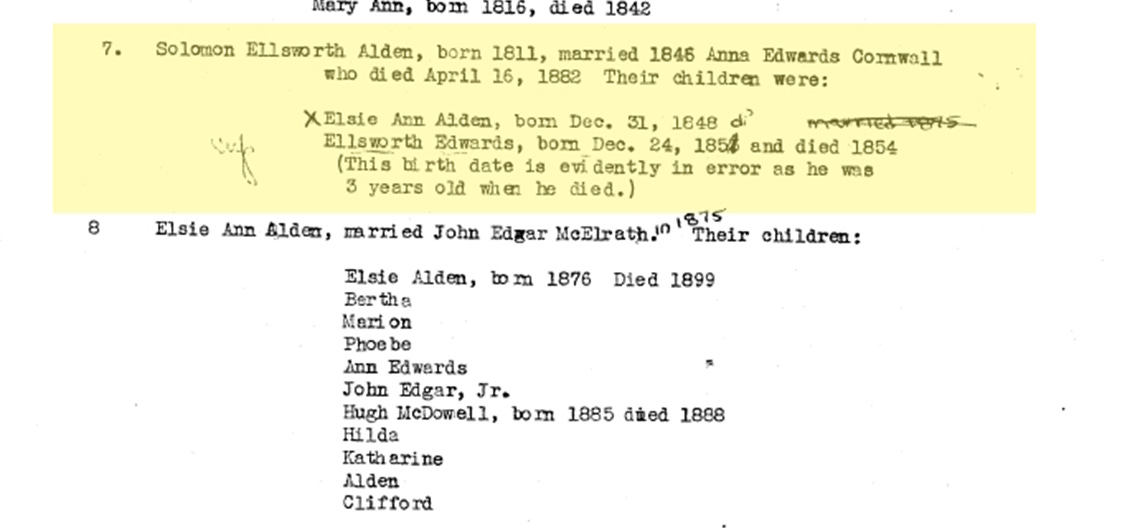
For this biography about my great-great grandfather Solomon Ellsworth Alden, all I had to go on when I was 19 was the information above, which was passed down to us from one of my grandpa Mac’s spinster sisters. I spent about four years after teaching working on a group of stories about ancestors.
Originally this information was researched and written by my great-grandfather John Edgar McElrath and passed down to his 11 children. Mom wrote family stories she heard as a girl when she was in high school (she earned a B+ but as an English teacher I would have given any student an A for writing a family story!).
You should tackle a facts of life story roughly in this order:
Research the basic information you have in the free www.familysearch.org, wikitree.com, or another service that you are using. I like these two because they are free and have some of the largest databases from throughout the world. Type in:
First name, last name
date of birth, or approximate date of birth
location of birth and/or death, if known
places lived, if known
occupation, if known
parents, if known
other family members such as spouse, children if known
This will give you enough information to get started.
Once you have identified the person in familysearch, if you are lucky you will find additional information from another family member or researcher (like me, I’m both) who has posted artifacts, stories, photos, and documents. You can also follow researchers to see who else might be in your family tree. If you have new information or artifacts you should post them for other researchers as I have. You can use photos, documents, and stories to begin creating a timeline of their life.
Most newspapers from the past have been digitized and archived online, and they are free or inexpensive to use—particularly if you are willing to help correct mistakes in the text. These archives exist in most states now, usually in a university. My alma mater University of Oregon houses an Oregon collection in its library. The one I use to research the family who headed to California after the Civil War is the California Digital Newspaper Collection housed at the University of California Riverside.
Research all the names in your family. In my case, researching the Alden and Cornwall line provided some information, and it was a story by my mother, Innes McElrath Melton, that told of the voyage around the Horn of South America to San Francisco. Including the McElraths in my Alden search gave me much more information about both families, enough to build a narrative of why they left, and what they created after they arrived.
Conduct an internet search. I found school records for Solomon Ellsworth Alden. It appears he studied to be a preacher. Not surprising, since there are a large number of preachers in the family tree. Religious freedom was at the forefront of our ancestors’ minds and was one of the major reasons they left England—that and the endless wars. Put quotation marks around the full name to limit the number of results, if needed—especially with more common names.
Document where your information came from. When creating links and references, include the author, date, title, and source information. For online sources, include the URL or DOI, and if available, a permalink or persistent URL. Always check the credibility of websites and ensure links are direct and functional. This information goes at the end of your work.
Conduct general background information on relevant aspects of your ancestor’s life. Solomon lived in Connecticut and worked in New York City, probably in finance. He may have had a farm, too, but it would have been small. You don’t just bolt from Connecticut to California and run a farm of this size, which takes some experience.

You can see that by the time of the 1870 census Solomon owns only 200 acres, but from this farming schedule you can see that for produce of market gardens he earned about $8,287.61, and produced 200 pounds of butter, 20 tens of Hay (20 bales of hay that weigh 100 pounds each, the total weight being 2000 pounds, or 1 ton), and $100 estimated value of all farm production ($42,815.25 today). John Edgar McElrath’s mother and father also lived and worked in NYC when they weren’t back at their home near Knoxville, Tennessee. We’ll never know, but it is possible that John and Elsie or their families may have met there. That interested me in researching the early days of the stock markets in NYC. Wikipedia provided some of the best-sourced information about the markets during their lifetimes, which provided essential background to their life and times. Solomon left Connecticut in 1852. What was going on then? If you said the California Gold Rush, you would be correct. He literally dropped everything and left the wife and kids behind. Upon further investigation, it’s clear he was after the brown kind of gold—real estate. The government was giving away 600 acres of other people’s land to develop the West. He was interested in the prime real estate, and his 600 acres included what is now Berkeley and Oakland. (Although I’ve heard family stories, I’ve never been able to find the evidence that UC Berkeley is built on the land he owned.)
Follow up on your leads.
I found postcards of his farm which included orchard, chickens, horses, cattle, and fruits and vegetables of every kind. When he enjoyed back for his fsmily, there were only three of them, so the farm wasn’t for a large family.
Eventually I ran across a wordpress site that wrote about the early history of San Francisco, and on it I found the answer: Solomon’s Epicurean Retreat. (First of all—Yes! That’s where I got the foodie gene and the excellent palate! Second, the farm provided all the food and beverage needed for his three or four SF restaurants!) The worpress article listed an amazing number of items on the menu. (See below) It was definitely fine dining. Printed at the bottom of the menu: “Gentlemen are particularly requested to report to the proprietor any inattention or want of civility on the part of any one conneted with the establishment.”
One other thing: Trust those things you’ve heard that don’t make any sense. Mom said her family served the first strawberries in San Francisco. That’s all she knew—and she was correct. The menu proved it. And I now have the rest of the story. There are also pieces of furniture and silver with their own stories which also turn out to be true. It’s in the will. The 170-year-old German upright piano in our living room came around the horn with Mrs. Alden and her daughter from Connecticut, and it’s not a C instrument—more like chords you would hear from a harp. I have to improvise so all the notes don’t sound like mush.
Solomon quickly realized the value wasn’t in the farm but in real estate and became a capitalist and served on a number of boards of directors, including an Oakland bank. He was engaged in a number of civic projects and networked with the more well-known old names in the East Bay, including the well-known Mountain View Cemetery, where some of our extended families are buried. Some of the information I gleaned was from the Mountain View Cemetery website, and a book written about the founders who are buried there. Looking at the farm schedule above, you will notice some well-known names of the adjacent farmers: Weston, Shattuck, Kirkham, Webster, Ashby, Davis, Burns, and others.
It’s also clear that he was a man of the people. When the Temescal Library was built, the people of the community wanted it named the Alden Branch in his honor. He sold his land to them, and took good care of the people in his community. I’ve told our own children that our family does the right thing whether anyone is looking or not, and I see that going back through the family lines, too. Sure, John Alden was accused of being a witch, but he was a smooth talker, a good guy, and no one believed the accuser! (Long story short.)
The PDF below is designed for easy readability, placing text on the left and related photos on the right. The link for instructions on how to design your family history pages are located at the end, in another post. You may also continue reading in Substack’s web-based one column layout for comparison.
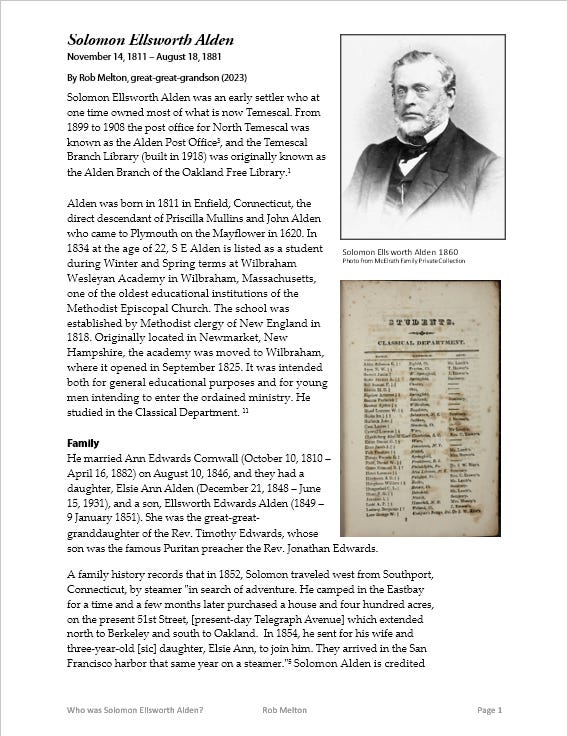
Note: The heading block of text is set using Substack’s More>Poetry menu to eliminate the automatic extra spacing between paragraphs.
Solomon Ellsworth Alden
November 14, 1811 – August 18, 1881
By Rob Melton, great-great-grandsonSolomon Ellsworth Alden was an early settler who at one time owned most of what is now Temescal. From 1899 to 1908 the post office for North Temescal was known as the Alden Post Office3, and the Temescal Branch Library (built in 1918) was originally known as the Alden Branch of the Oakland Free Library.1
Alden was born in 1811 in Enfield, Connecticut, the direct descendant of Priscilla Mullins and John Alden who came to Plymouth on the Mayflower in 1620. In 1834 at the age of 22, S E Alden is listed as a student during Winter and Spring terms at Wilbraham Wesleyan Academy in Wilbraham, Massachusetts, one of the oldest educational institutions of the Methodist Episcopal Church. The school was established by Methodist clergy of New England in 1818. Originally located in Newmarket, New Hampshire, the academy was moved to Wilbraham, where it opened in September 1825. It was intended both for general educational purposes and for young men intending to enter the ordained ministry. He studied in the Classical Department. 11
Family
He married Ann Edwards Cornwall (October 10, 1810 – April 16, 1882) on August 10, 1846, and they had a daughter, Elsie Ann Alden (December 21, 1848 – June 15, 1931), and a son, Ellsworth Edwards Alden (20 December 1848 – 9 January 1851). She was the great-great-granddaughter of the Rev. Timothy Edwards, whose son was the famous Puritan preacher the Rev. Jonathan Edwards.
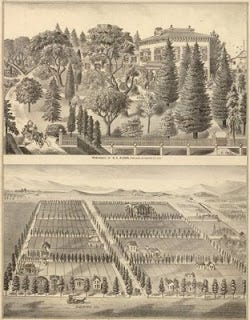
A family history records that in 1852, Solomon traveled west from Southport, Connecticut, by steamer "in search of adventure. He camped in the Eastbay for a time and a few months later purchased a house and four hundred acres, on the present 51st Street, [present-day Telegraph Avenue] which extended north to Berkeley and south to Oakland. In 1854, he sent for his wife and three-year-old [sic] daughter, Elsie Ann, to join him. They arrived in the San Francisco harbor that same year on a steamer."5
Solomon Alden is credited with the original settlement of the Temescal area, which bore his name prior the turn of the 20th century. Alden acquired land along the road, eventually holding 600 acres between 44th and 60th streets. He began subdividing the land along Telegraph around 1868, perhaps in anticipation of the streetcar line that was built the following year. Alden’s subdivision developed into a commercial district along Telegraph Avenue, supported by the horse-drawn streetcar that ran from downtown Oakland to Berkeley by 1873 and the Oakland-Sacramento telegraph line, which was strung down Telegraph Avenue and gave the street its name.10
Solomon's sister Emily (January 22, 1810 – October 7, 1881) and niece Ann also lived with the family.
The family history goes on: “When Mrs. Alden arrived in North Temescal, as the district was then called, she disliked the bareness of the yard, and she was homesick. She sent back to Connecticut for a small magnolia tree (often misidentified as a bay tree in early family stories), and when it arrived planted it outside in the front yard. There were no water pumps in those days [not true], so every day after the dishwashing she would pour the water on her growing magnolia tree. It grew immensely and for many years has afforded shade to Oaklanders.... In 1915 the Alden house was sold to the Oakland Baby Hospital. Eventually, the old Alden homestead was taken down and a new Baby Hospital was built.” 5 The old magnolia tree still stands at the Children's Hospital and Research Center Oakland.
Originally the home of the Ohlone people, who settled along the creek, by 1873 the population of the village of Temescal numbered 1,000 and the village featured stores, restaurants, dairies, and banks, according to a report prepared for Oakland Children’s Hospital for a rebuilding project.7 Early Temescal was a blue-collar community of carpenters, farmers, and laborers, according to the report.
The local Lusk Canning Company, which opened in 1868, was one of the largest canning factories in the world by 1885. It employed 800 people, both adults and children, during the height of the canning season. In its heyday, the factory was located on Claremont Avenue just north of the intersection of Claremont and Telegraph Avenue. Many Temescal residents also worked in the streetcar barn at 51st Street and Telegraph Avenue, and it was common for women to work in cigar factories and laundries. A number of garbage collectors also operated in the area and in 1907. 10
In 1897, just after residents voted to change the town’s name to Alden in honor of its founder, Temescal was annexed by the growing city of Oakland. At the turn of the 20th century, Temescal was still a relatively self-contained community, with several small dairies, four movie houses, a post office, and a store. Idora Park, an amusement park that boasted the largest roller-skating rink on the West Coast, was established in 1903 between Shattuck and Telegraph avenues and 56th and 58th streets. 10
By 1862 S. E. Alden, Esq., had become a lawyer and an advertisement listed about 350 acres for sale, with "a good Dwelling House, containing Ten Rooms; two Servants' Rooms, and Five large Closets and Bath Rooms, all hard finished, and Four Handsome Marble Mantles…" plus a farm house with eight rooms not including rooms for farm laborers, a one-and-a-half stories high 20x40 carriage house, two large barns, and stables for 125 head of cattle and 20 hourses.4 Alameda County records list Alden's property at 300 acres; the same year the Assessor's office listed him as the fourth wealthiest property owner in Alameda County after Edson Adams, Samuel Merritt and Frederick William Delger. At one time almost all of the Temescal area was owned by S. E. Alden. Solomon E. Alden planted extensive orchards along Temescal Creek in North Oakland in the 1850s. Friends used to come to his house to eat cherries and chat. 1
According to a footnote in The American Menu: "There were many ways to make money during the Gold Rush. The trick was not to lose it in the saloons, gambling halls, and houses of ill repute. By the 1870s, restaurateur Solomon E. Alden was listed in the city directory as a bank director and farmer, living on a 612-acre estate comprising much of the Temescal area of Alameda County." 6
1852: Solomon and Ann Ellsworth Alden purchase the land between 44th and 60th streets. A wood frame dwelling on the property is expanded to a two-story Italianate residence.
1860: Women in the Alden family plant a magnolia tree next to their home.
1868: Alden begins to subdivide his land into residential tracts.
1878-1899: A two-and-a-half story Queen Anne style mansion replaces the earlier Italianate structure. The new 20-room house at 52nd and Dover Street is located at the center of the large lot.
1897: Reflecting this development, the area of North Oakland known variably as Alden and Temescal officially become part of Oakland by annexation in 1897.
1912: The Baby Hospital Association purchases the McElrath mansion.
1913: The Baby Hospital Association opens a medical clinic in the McElrath carriage house in June, during the renovation of the McElrath mansion.10
He farmed his land, delivering fresh produce to his three restaurants in San Francisco, Alden's Epicurean Retreat. 6 According to the blog The American Menu, the menu for Alden’s Epicurean Retreat "was made by the Excelsior Print Company, situated next door to the picturesque Niantic Hotel that had been built in a beached whaling vessel. In addition to fish and game dishes sourced from the West, such as salmon, venison, and elk steaks, the menu below offers three Boston eggs for 37 cents, reflecting the competitive dynamics in a city filled with saloons, restaurants, and hotels. Alden’s menu also features a California egg for 25 cents. Although many farms had been established in the area by 1853, the high price of local eggs indicates that they were still relatively scarce. It would be another twenty years before the chicken industry got rolling in Petaluma, eventually becoming known as the 'Egg Capital of the World.' " 6 According to his great-granddaughter Innes McElrath Melton, he served the first strawberries in San Francisco, grown on his farm.5
While the 1870 census listed his occupation as farmer worth $200,500 (a relative worth of wealth held that would be about $80 million today8), by 1880 his occupation had advanced to "capitalist" and his net worth $334,300 (worth about $114.5 million today8). He was a founder of the Oakland Bank of Savings along with Walter Blair and Frederick Delger. 1 Alden was a trustee and also served on the first board of directors of Mountain View Cemetery with Hiram Tubbs, Dr. Samuel Merritt, J. A. Emery, Rev. I. H. Brayton, William Faulkner, Rev. T. S. Wells, G. E. Grant, J. E. Whitcher, Major R. W. Kirkham, W. H. Bovee, Henry Robinson. 1,2,9 According to the assessor's returns in 1875 the following were among the rich men of Oakland township: Edson Adams, $355,680; Samuel Merritt, $293,675; Fred Delger, $210,390; S. E. Alden, $190,750; Michael Reese, $141,350; P. S. Wilcox, $127,350; Peder Sather, $112,072; G. C. Potter, $108,314; H. W. Carpentier, $103,250.
There were so many boom and bust cycles in America at the time that people made and lost fortunes throughout their lives. Let’s look at two examples, the Aldens and the McElraths, using well-sourced information from Wikipedia (not this teacher’s usual preference for research projects), and remember that one person’s Recession or Panic can look or feel to another person like a Depression.
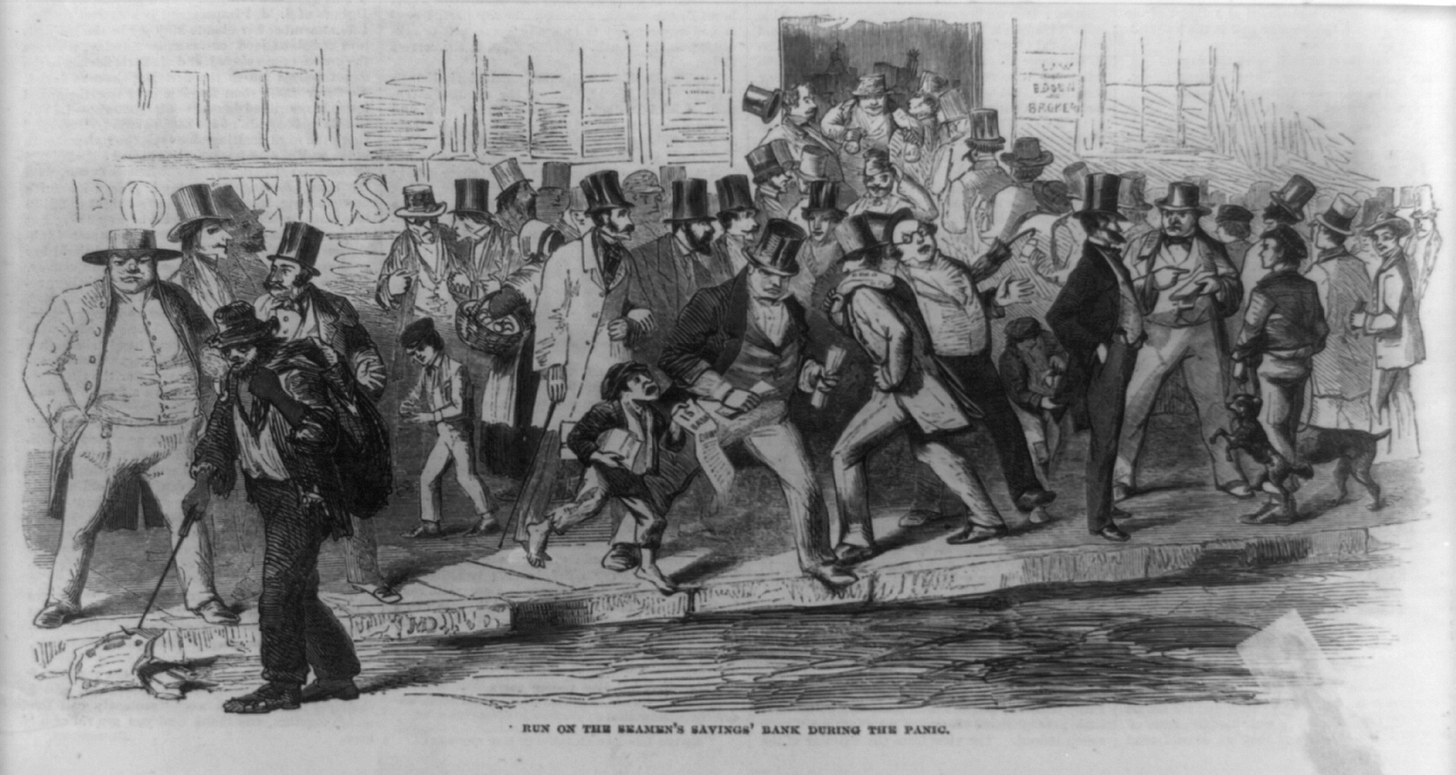
Solomon Ellsworth Alden (1811-1881) and Ann Edwards Cornwall (1810-1882) and their two children, Elsie Ann Alden (1848-1938) and Ellsworth Alden (1849-1851) lived through 13 Recessions, two Panics (which brought the economy to a screeching halt, one of which was followed by a depression), and two Depressions from 1810-1882. In the 19th century, recessions frequently coincided with financial crises.
The consensus view among economists and historians today is that “The cyclical volatility of GDP and unemployment was greater before the Great Depression than it has been since the end of World War II,” according to The Journal of Economic History in 2009. The Wikipedia entry concludes “Before the COVID-19 recession began in March 2020, no post-World War II era had come anywhere near the depth of the Great Depression, which lasted from 1929 until 1941,” according to the lists of recession article on Wikipedia.
Daughter Elsie, the last of that Alden line, married John Edgar McElrath, and they had 11 children. John Edgar McElrath and Elsie Alden saw 15 Recessions, six Panics (one of which led to a depression), and four Depressions during their life.
Two generations of family lived through four Depressions (including the Great Depression), six Panics (almost as bad as a Depression), and 15 Recessions. The Great Depression was a game-changer for everyone.
I have drawn one conclusion, though: Investments in land, especially farms during the pre-Great Depression era, were always a good investment, and may still be today. Maybe S E Alden had seen enough of the swing cycle, living in Connecticut, and working in New York City, but in 1852 he sailed around Cape Horne and ended up in San Francisco, where the U.S. government was selling out land front under the feet of the Muwekma Ohlone, nomadic natives who had lived on the land since time immemorial. He bought his two allotments, started a farm-to-table restaurant, and eventually used the cash to buy and sell more real estate, after which he was able to change his status from farmer to capitalist.
It seems to have been a way to protect his wealth from the ups and downs of America’s economy. Although economists and historians agree there is less volatility today than before the Great Depression, it also seems like we are forgetting the lessons that led to peace and prosperity that may lead us back to a more perilous time.
Legacy

His daughter Elsie Alden, born in Rochester, New York, married John Edgar McElrath, born in Tennessee (January 2, 1844 – May 6, 1907), who studied law and was admitted to the Bar in Knoxville, Tennessee, and then served as an attorney and counselor in Cleveland, Tennessee.5 On June 23, 1869, McElrath moved from Tennessee to San Francisco, where he practiced law until 1887. During that time he resided in Oakland, and in 1887 McElrath moved his law offices from the City to Oakland.5
On September 23, 1875, McElrath married Elsie Ann Alden, daughter of Solomon E. Alden and Ann Edwards Cornwall, and together they had eleven children. The 1880 census lists their address as 668 17th Street. By 1908 the city directory lists their address as 5101 Dover Street.
Between 1878 and the turn of the 20th century, a large Queen Anne style house was constructed on the property, which came to be known as the McElrath mansion, and which replaced the earlier Alden Italianate structure. The sprawling two-and-one-half story home contained 20 rooms.
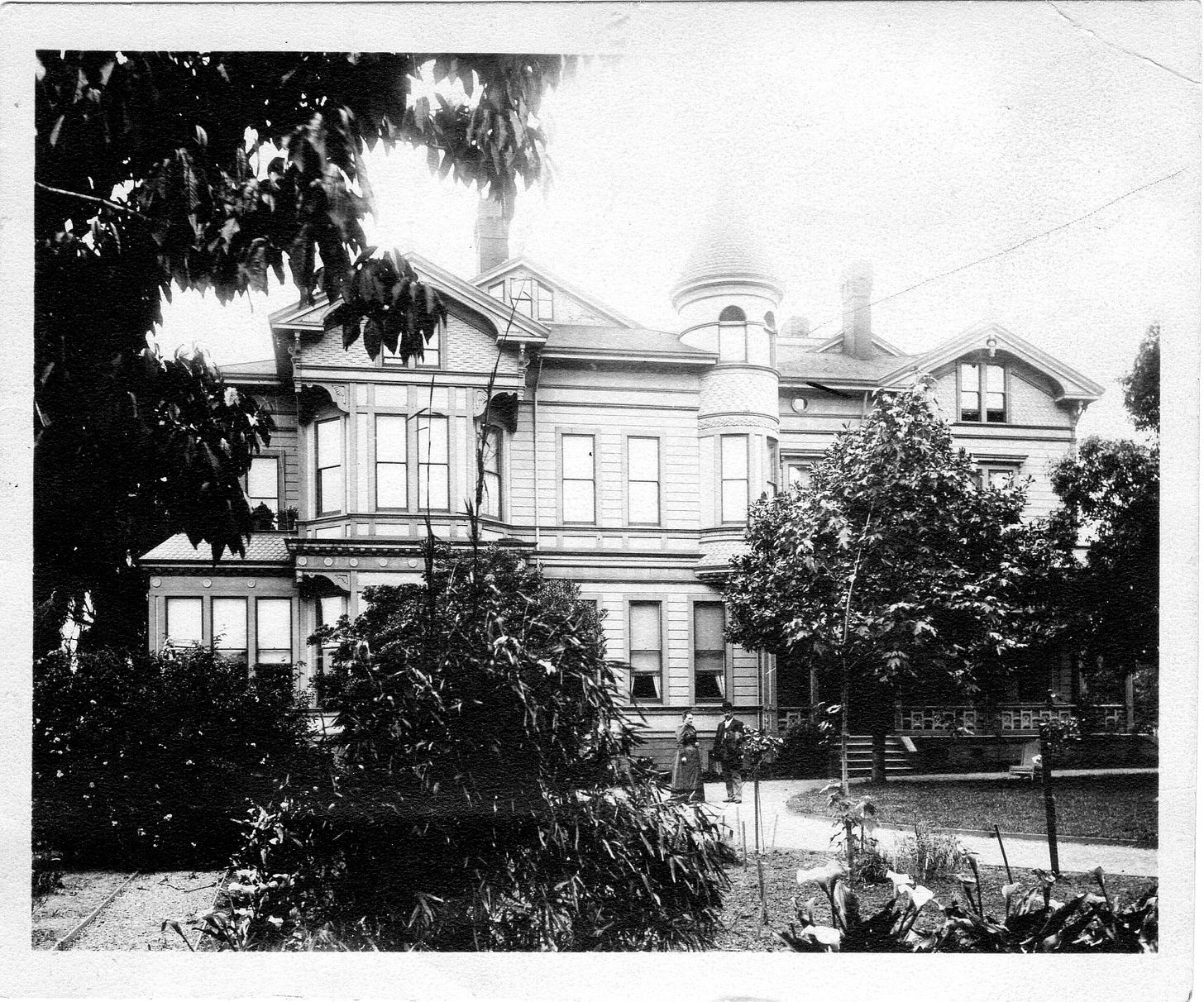
In 1912 a nurse and a social worker established the first West Coast hospital for babies and raised $12,500 for the administrative, title, and tax expenses to transfer the McElrath estate at 51st and Dover Streets to the new Children’s Hospital. The mansion's stables were cleaned out and on September 6, 1914 officially opened as the Baby Hospital with 38 beds. The original S. E. Alden property became the site of the Children's Hospital Oakland,5 a place the family would go when its children needed specialized care.
S. E. Alden’s son-in-law followed in his footsteps. He was a delegate to the National Democratic Convention in 1880, where he placed Stephen J. Field of the United States Supreme Court, in nomination for President of the United States. He ran for public office as the Democratic candidate for State Senator, and Superior Judge, but was defeated. McElrath was a Royal and Select Mason.
Along with John W. Coleman and George McNear, J.E. McElrath founded the Oakland Consolidated Street Railway, the first electric railway system built in the Bay Area. In 1893, Francis M. Smith bought controlling interest in the company and consolidated them in what became the Key System.
When Solomon Alden died of diabetes in 1881, the property was turned over to his daughter Elsie to manage. She turned over day-to-day management of the family business to her son Alden McElrath to manage in later years.
Death and Burial
The Alden–McElrath family grave site in Plot 1 is still in use as a family plot by some family members. The early settlers are buried in Mountain View Cemetery.1 In recent years a new grave marker was added.
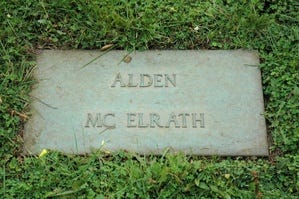
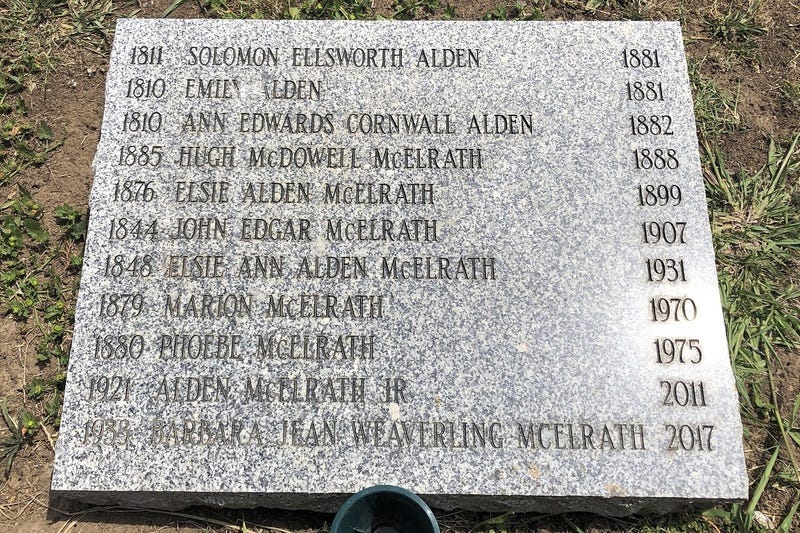
Links and References
Solomon E. Alden (1812-1881): Farmer, Founding Trustee of Mountain View Cemetery Lives of the Dead by Michael Colbruno
S. E. Alden on first board of directors of Mountain View Cemetery. History of Alameda County, California.
Alden Post Office, USGS GNIS - note that this is in Montclair Village.
California Digital Newspaper Collection is a project of the Center for Bibliographical Studies and Research (CBSR) at the University of California, Riverside.
An English paper written by Innes McElrath in 1943 about her family, a great-granddaughter of Solomon Ellsworth Alden. McElrath Family private collection. Other family stories.
http://www.theamericanmenu.com/2013/01/fresh-eggs-in-california_23.html
A creek ran through it, OaklandNorth (with a map of the Town of Alden)
Measuring Worth used to calculate approximate wealth for modern audience: https://www.measuringworth.com/dollarvaluetoday/
List of recessions, panics, and depressions in the United States: https://en.wikipedia.org/wiki/List_of_recessions_in_the_United_States
Mountain View Cemetery Founders: http://blog.ouroakland.net/2011/12/mountain-view-cemetery-founders_28.html
Children’s Hospital and Research Center Oakland Campus Master Plan Project Draft Environmental Impact Report, August 2014.
Familysearch.com: Solomon Ellsworth Alden. 2023
Rob Melton grew up in the San Francisco Bay Area – great-grandson of John Edgar McElrath and Elsie Ann Alden, and James Alexander Smilie and Isabella Lawrence McDonald, and great-great-grandson of Solomon Ellsworth Alden (Mayflower descendant) and Ann Edwards Cornwall (great-great-granddaughter of the Rev. Timothy Edwards).
Why you should print your document, an easy way to design it, and four reasons you family wants it that way
If you would like to see a complete finished design for the print version of my dad’s “facts of life” biography before you see how to design it, click on the image below—with a newly-discovered picture of dad taken by mom on the Coronado beach. Otherwise, jump over this link and come back to it later.
How to write nonfiction narratives about ancestors with drama, flair, grammar – even movies and memoir!
Family history stories are really memoir, and the secret to memoir is that there are two narrators: The one in the past living the stor…
facts of life: A few stories about dad
My siblings and I used chat to gather first-person stories and reminiscences about our father. Then I polished them a bit, and finding the collage a bit unstructured, rewrote it a couple of more times. In the process, I learned more about him through newly discovered scrapbooks, as well as more about myself. Enjoy!
The tradition of tea:10 steps to your first family history story, plus 3 tips to get started; and the matter of manners and tea
Ready to write your own memoir short stories? If you have been meaning to write the first draft of your family's history — if you are game — here are some ideas, and you don't have to be a professional writer to do this! The idea for this list came after a vi…
A journalist's step-by-step guide to writing death notices, obituaries, narratives, and life stories
As we were discussing extended family members who had died last year, there was considerable debate about the timeliness of a distant family’s intentions of memorializing their parents’ lives (it has been several months).
She squeezed every last teary-eyed drop of Civil War Drama into everything she wrote
Yesterday, my second cousin in Vermont sent me a newly discovered letter from 1863 she found in an old family trunk handed down to her. Last year, she found the book of poems of our great-great-grandmother in this trunk. I’d been persistently (annoyingly) asking everyone if they had ever seen it. I then spent the next six months transcribing and studyin…




















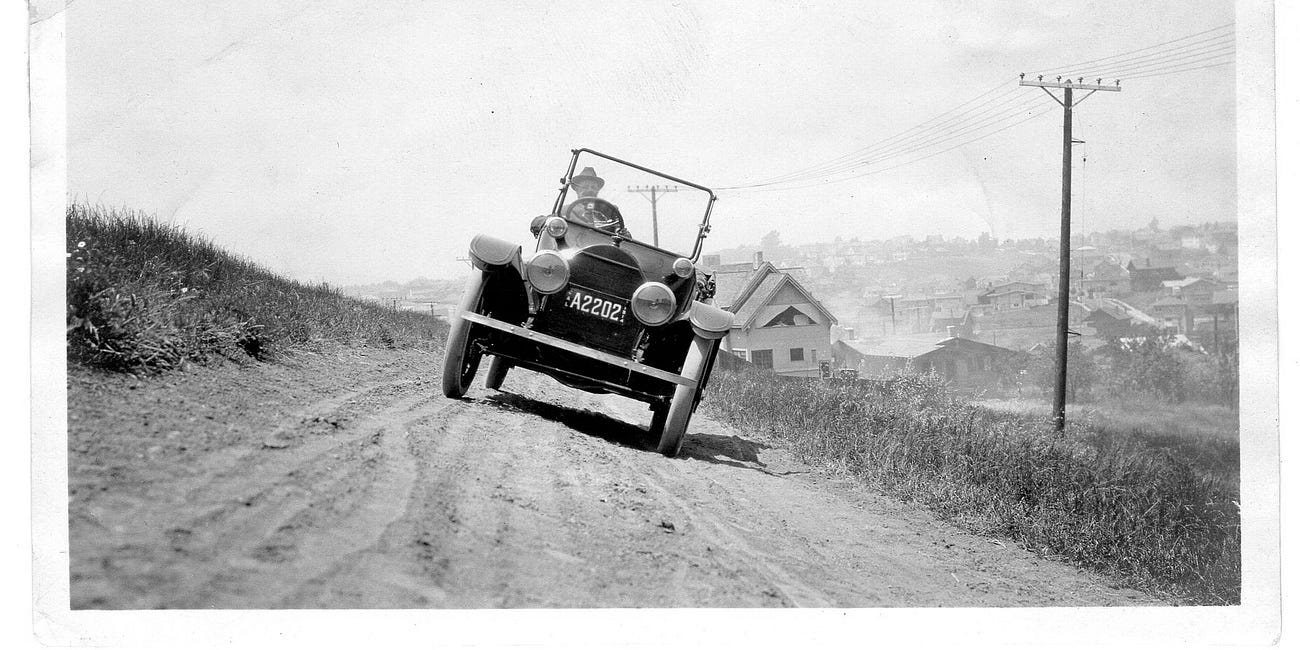





Amazing findings! Thank
you so much for pulling it all together!